Grade II* listed North Street in Cromford is a hugely important street. It was built in 1776-7 by the cotton-spinning pioneer Richard Arkwright to house workers in his new cotton mill and is generally acknowledged as the world’s first industrial housing. These are well-built little, three-storey houses with a nod to Classical symmetry, and good-sized gardens to the rear. Landmark has owned eight of the terraced houses since 1974, saving them from demolition. No. 10 is the Landmark let; the others are let residentially.
Major cyclical maintenance on our houses in North Street had been planned for some time, but then in March 2020, the Covid-19 pandemic hit.
We were very grateful to receive a major grant channelled by Historic England from the Cultural Recovery Fund (CRF), set up by the government during the pandemic to support cultural sectors. This enabled the North Street works to go ahead when Landmark’s holiday income, which pays for the maintenance of our buildings, dried up for nine out of twelve months during lockdown.
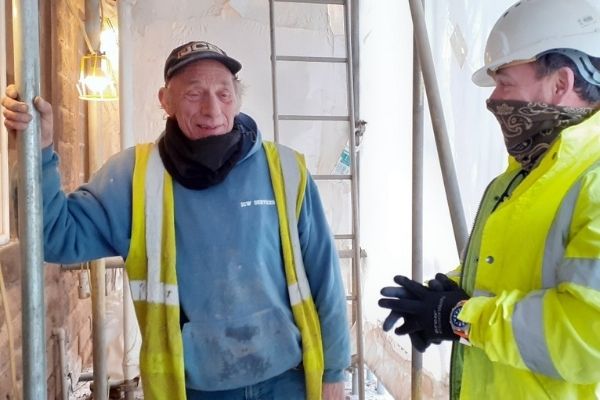
Project manager Stuart Leavy (left) on site with site foreman Neil Goodall (right).
Work began in October 2020 for completion late March 2021. This timing through the winter avoided disturbing the nesting season of the swifts that return every year to the eaves of the terraces.
The scaffolding required a lot of outrigging and kentledge (or ballast) and we’re very grateful for the patience of the street’s residents through the inevitable disruption this caused to daily life.
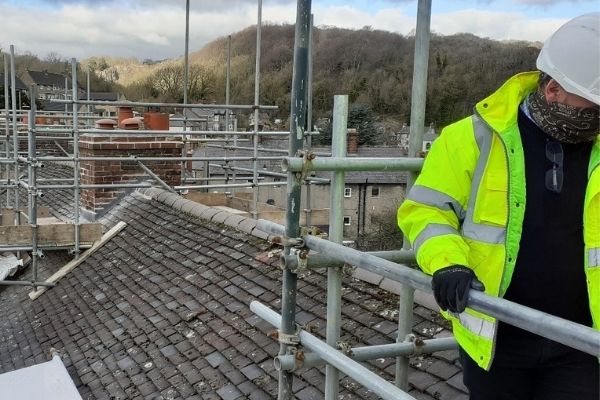 Rooftop scaffolding.
Rooftop scaffolding.
The houses are built of local gritstone, a surprisingly friable red sandstone. Most of the houses had been ill-advisedly repointed with wide cement joints before Landmark’s arrival, trapping the original lime pointing beneath. The gritstone was literally crumbling around these joints, damaged by water trapped by the hard cement. To retain as much existing stone as possible, loose surfaces were simply brushed back. Blocks were only replaced where there was more than 50mm erosion across the whole face, using local Birchover stone.
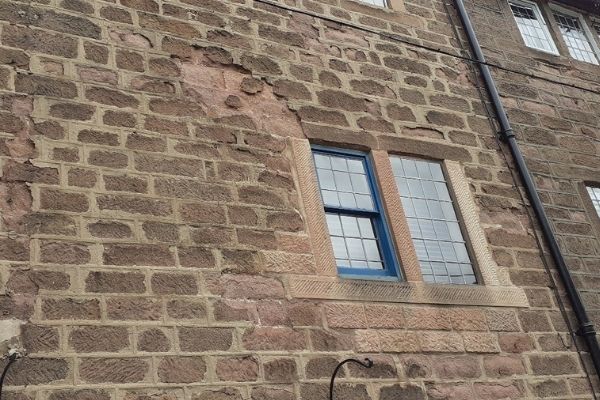
The damage caused to the soft gritstone by hard cement pointing.
After careful discussion, we decided simply to rake out the cement pointing, exposing and leaving intact the original lime joints which are holding well (these primary joints are mostly very thin). This original mortar mix is softer than the stone, so joints and gritstone breathe equally: less water will be trapped and there will be less erosion of the gritstone.
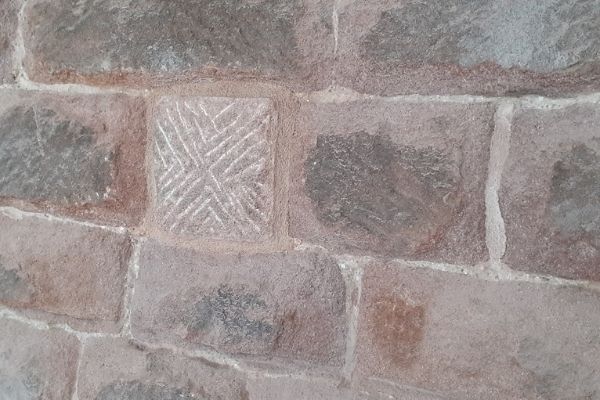
Masonry brushed back to original pointing, with a replacement block (centre) marked up for tooling.
The masons set up a banker’s shed in the back garden of No 10, where they dressed replacement blocks and window dressings. The 1770s masons had tooled each block beautifully as they dressed it, and all new work has been tooled to the midline with similar care under the supervision of master mason Ian Williams. Apprentice Adam Winson worked alongside the experienced masons, gaining valuable experience.
Apprentice Adam Winson raking out cement joints alongside master mason Ian Williams.
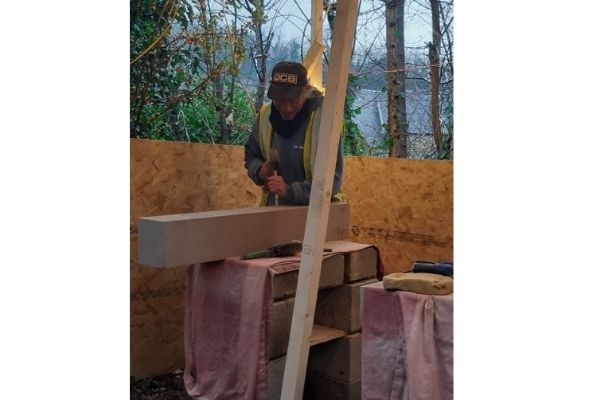
The bankers shed at the back of No. 10.
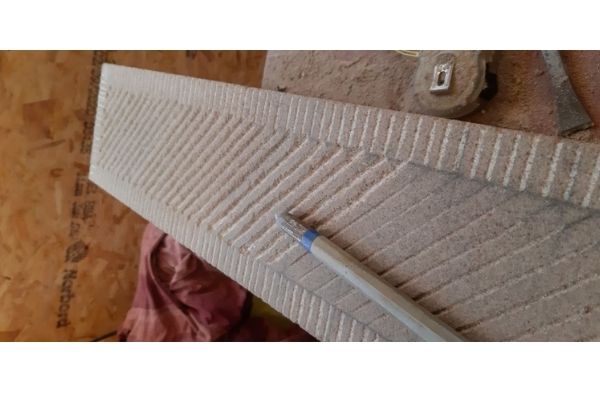
A hand-tooled lintel.
Door jambs were being pushed out by their original cast iron pins as they corroded. These have been drilled out and re-fixed with specially made gritstone dowels.
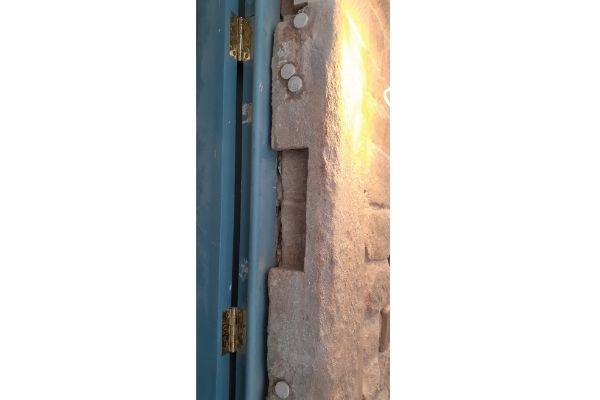
Original door jamb repined with stone dowels.
Plastic repairs have been made to the stone jambs and window dressings wherever possible. (‘Plastic’ refers to the repairs being modelled in situ rather than to the material used, which was a self-coloured 1:1 lime mix). For larger repairs, stainless steel pins with copper wire wound round them were used to provide a skeleton for the new mortar to key to. The new mortar for these repairs was made of non-hydraulic lime. A good colour match was obtained by carefully keeping sweepings as decayed gritstone was brushed back.
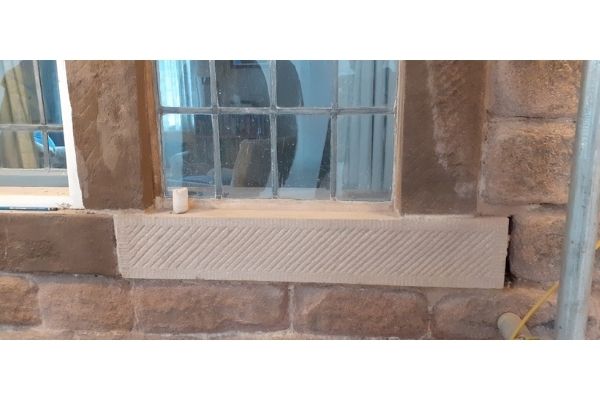 Replacement window sill. The darker areas show areas of ‘plastic’ repair in lime.
Replacement window sill. The darker areas show areas of ‘plastic’ repair in lime.
The 1970s roof coverings of plain clay tiles were found to be in generally good condition, but the chimney stacks were once again suffering from ill-advised cement repairs. They were re-pointed and re-flaunched, using a hot lime mortar for greater weather resilience. Hot lime is a mix made by stirring quick, or unslaked, lime directly into the aggregate and water, rather than slaking the quick lime first.
Doors and windows have been all overhauled and kept, or returned, to their eighteenth-century form, and redecorated in linseed oil paint in their original shade of soft blue. A few of each had to be re-made, the carpenters following the survey drawings of Arkwright-era originals sensibly taken by the local authority in the 1970s. The top floors have the long, four-light windows that lit the weavers’ looms - typically, it was the nimble-fingered women and children who worked long hours in Arkwright’s cotton mills spinning the raw cotton picked by enslaved people on plantations in America’s Deep South, while the men stayed at home to weave the thread into cloth as piecework.
Thanks to the Cultural Recovery Fund, these major works have not only benefited Landmark’s buildings but also provided months of secure employment for the specialist craftspeople who carried out the work.
Landmark Project Manager: Stuart Leavy
Contractor: H.A. Briddon Ltd of Tansy, Matlock
Site Manager: Neil Goodall
Lead Mason: Ian Williams
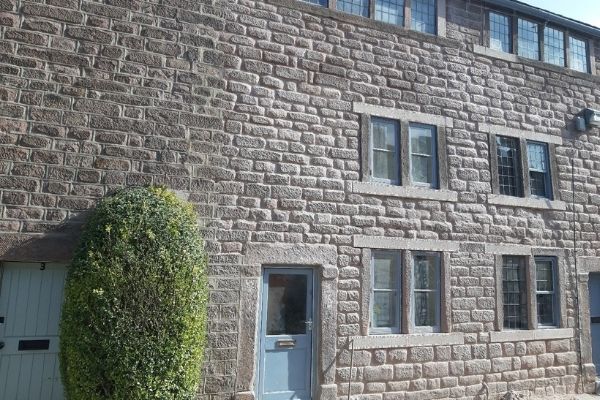 One of the newly refurbished cottages.
One of the newly refurbished cottages.